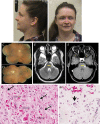Atypical Alexander disease with dystonia, retinopathy, and a brain mass mimicking astrocytoma
- PMID: 30046660
- PMCID: PMC6055357
- DOI: 10.1212/NXG.0000000000000248
Atypical Alexander disease with dystonia, retinopathy, and a brain mass mimicking astrocytoma
Figures

References
Grants and funding
LinkOut - more resources
Full Text Sources
Other Literature Sources
Medical
